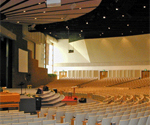The challenge with contemporary church architecture is that the term “contemporary” means a lot of different things to a lot of different people. For some, it means a praise band and a projector. For others, it means the service is full of drama, dance, video, interactive preaching, and more. With all the different styles, a lot of contemporary churches feel stuck in the middle with facilities that are in between “where it is” and “where it ought to be.”
Going in the right direction
A staple of contemporary church sanctuaries has been the fan-shaped room where the seating is positioned in a semi-circle around the stage. Architecturally, this moves more people closer to the platform for a more “intimate” feel. Acoustically, this can be a step in the right direction – especially compared to the traditional box-shaped rectangle found in many churches. When working with acoustics, getting away from large parallel walls is generally a good place to start. However, the large rear wall must be properly designed or it can act as a focusing beam for the sound. Room shape, ceiling height, and surface materials all play a dramatic role in determining the overall acoustics.
When we speak of room acoustics for contemporary sanctuaries, we’re generally talking about striking some balance between diffusion and absorption. Put in plain terms, diffusion measures how the acoustical energy “bounces” off the room’s surfaces, and absorption tells us how much is “soaked up” when it hits an object. Too little diffusion can leave a room sounding “hot” and “cold” (think “live spots” and “dead spots”.) On the flip side, too much absorption can make a room sound acoustically dead and lifeless.
To strike a good balance, the designers have to consider the functional needs of the space as important as the physics of the room. If you do it right, you can create a great sounding worship space.

I know exactly what you mean, and we’ve experienced these same types of challenges at my church. The tough thing is convincing a church board that acoustical treatment will actually help improve the communication from the platform. Unfortunately, this is often looked at as an unnecessary expense.